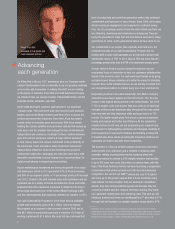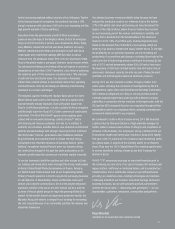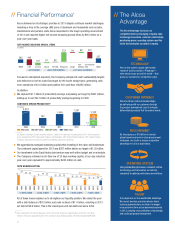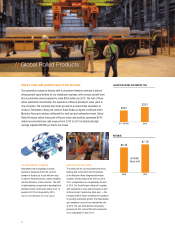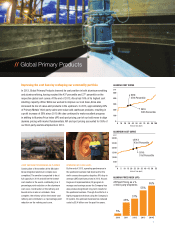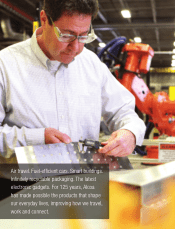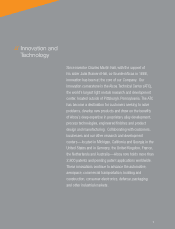Alcoa 2013 Annual Report Download - page 12
Download and view the complete annual report
Please find page 12 of the 2013 Alcoa annual report below. You can navigate through the pages in the report by either clicking on the pages listed below, or by using the keyword search tool below to find specific information within the annual report.
Driving the future of autos
Alcoa scientists invented a disruptive
bonding technology, known as Alcoa 951,
which allows for more durable bonds
when joining aluminum to itself or other
materials. In 2013, Alcoa commercialized
this breakthrough process and today the
technology is enabling the historic shift
to aluminum-intensive automobiles,
opening the door to safer, more fuel-
efficient cars and trucks. Additionally,
the technology is up to nine times more
durable than previously used titanium
zirconium, and has already become the
auto industry standard.
Alcoa has been innovating surface
treatment and coating technologies for
the past 40 years. Beyond Alcoa 951,
the Company has produced products
that have opened market applications
across industries, from surface treatments
for aerospace structures and durable,
low-maintenance commercial truck
wheels, to anodization and coating
technologies for durable, sustainable
building and construction materials and
aesthetic treatments for colorful consumer
electronic devices.
Propelling aircraft performance
Alcoa invests more than $40 million
each year to develop new products and
cutting-edge aerospace technologies
as part of its approximately $4 billion
aerospace business. Since the beginning
of aviation, Alcoa’s teams have worked
side-by-side with aircraft manufacturers
to advance air travel.
Our latest efforts have centered on
advanced cooling systems to help aircraft
and engine manufacturers increase
engine fuel efficiency. Our single-crystal
and 3-D core technologies for advanced
airfoil castings and coatings can withstand
the extreme temperatures of high-
performance and clean-burning aircraft
engines, where operating temperatures
exceed the melting point of the metals.
We’ve also reduced the thickness of the
engine blade, cutting weight by up to
20%, and our titanium aluminide airfoil
offers a 50% mass reduction versus a
super alloy with a nickel-base—improving
aerodynamics and weight, and therefore
turbine fuel consumption. Innovations
such as these continue to position Alcoa
to capture opportunities in a fast-growing
global aerospace market.
Keeping soldiers safe
Alcoa’s powerful combination of advanced
materials expertise and ability to forge
the world’s largest aluminum structures
resulted in a joint Alcoa-Army Research
Laboratory effort in 2013 that is poised
to help the U.S. Army better protect its
troops against Improvised Explosive
Devices (IEDs), a grave threat to soldier
safety. Alcoa and the Army Research
Laboratory launched a program to develop
the world’s largest, high-strength, single-
piece aluminum hull, which would replace
today’s welded and assembled hulls—a
potential game changer for how combat
vehicles are designed and made to better
protect soldiers.
A single-piece hull covering the entire
lower section of any combat vehicle
would eliminate welded seams used
in today’s manufacturing processes,
which is expected to significantly
improve protection. The use of more
blast-absorbent Alcoa alloys is expected
to further increase damage resistance.
Forging hulls as one unit would facilitate
three-dimensional shaping, allowing Alcoa
to tailor the thickness where needed to
maximize protection and allow for weight
savings. In addition, the structure is
expected to reduce costs over the life of
the vehicle by increasing fuel efficiency
through lightweighting and eliminating
assembly time and complexity.
10




